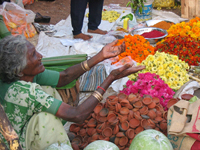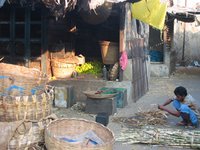 Indian tradition has made no distinction between craft as art or as industry. Our crafts served both functional and aesthetic purposes. Pottery is as ancient as human civilisation and is perhaps, the first craft which came to be also a thing of beauty and artistic expression. Today, the earthen pot has little utilitarian value in the cities. The plastic containers, shaped often like the earthen pot, have come into use. There is the stainless steel filter that holds water, which runs from a tap and is not carried anymore to the house from a well. In the Bazaar, what are the products that can continue to be our ‘crafts’? Are these as refined as the work of our earlier craftsmen? Do bazaars generate their own genre of crafts?
Indian tradition has made no distinction between craft as art or as industry. Our crafts served both functional and aesthetic purposes. Pottery is as ancient as human civilisation and is perhaps, the first craft which came to be also a thing of beauty and artistic expression. Today, the earthen pot has little utilitarian value in the cities. The plastic containers, shaped often like the earthen pot, have come into use. There is the stainless steel filter that holds water, which runs from a tap and is not carried anymore to the house from a well. In the Bazaar, what are the products that can continue to be our ‘crafts’? Are these as refined as the work of our earlier craftsmen? Do bazaars generate their own genre of crafts?Thursday, December 28, 2006
Crafts in Bazaars
 Indian tradition has made no distinction between craft as art or as industry. Our crafts served both functional and aesthetic purposes. Pottery is as ancient as human civilisation and is perhaps, the first craft which came to be also a thing of beauty and artistic expression. Today, the earthen pot has little utilitarian value in the cities. The plastic containers, shaped often like the earthen pot, have come into use. There is the stainless steel filter that holds water, which runs from a tap and is not carried anymore to the house from a well. In the Bazaar, what are the products that can continue to be our ‘crafts’? Are these as refined as the work of our earlier craftsmen? Do bazaars generate their own genre of crafts?
Indian tradition has made no distinction between craft as art or as industry. Our crafts served both functional and aesthetic purposes. Pottery is as ancient as human civilisation and is perhaps, the first craft which came to be also a thing of beauty and artistic expression. Today, the earthen pot has little utilitarian value in the cities. The plastic containers, shaped often like the earthen pot, have come into use. There is the stainless steel filter that holds water, which runs from a tap and is not carried anymore to the house from a well. In the Bazaar, what are the products that can continue to be our ‘crafts’? Are these as refined as the work of our earlier craftsmen? Do bazaars generate their own genre of crafts?Tuesday, December 26, 2006
Advertising the goods
 One sees advertisements painted on walls in the markets, hoardings that hide heritage market buildings.
One sees advertisements painted on walls in the markets, hoardings that hide heritage market buildings.Advertising takes many forms and has begun to have considerable influence on contemporary society and commerce. But this was not always true. In the past, people lived in small, isolated communities where artisans and farmers bartered goods and services among themselves. "Distribution was limited to how far people could walk, and advertising to how loud they could shout"
Monday, December 25, 2006
Aesthetics in the Bazaar
 Each vendor finds his own way of displaying the goods and makes a shelter within the given area with materials locally and easily available, with an aesthetic very much his own. This means that no shop has the same design because the parameters are not same; each is built within a different context. This applies to open bazaars where it is much easier to establish one´s own identity and define one´s own boundaries. It is an aesthetic that is native to the region, that cannot always be uprooted for use elsewhere.
Each vendor finds his own way of displaying the goods and makes a shelter within the given area with materials locally and easily available, with an aesthetic very much his own. This means that no shop has the same design because the parameters are not same; each is built within a different context. This applies to open bazaars where it is much easier to establish one´s own identity and define one´s own boundaries. It is an aesthetic that is native to the region, that cannot always be uprooted for use elsewhere. Saturday, December 23, 2006
Planning for the Transition
 Today, most towns and cities find it difficult to improve on existing markets because it is difficult to temporarily relocate the market elsewhere. Within the city, there is often no area available to insert a new market. The available option is usually to relocate them to the peripheral areas which are not so well connected by public transport or even if they are, customers find it tedious to travel large distances for their daily shopping. With markets, it is almost impossible to start work at any time and put up a board that says,
Today, most towns and cities find it difficult to improve on existing markets because it is difficult to temporarily relocate the market elsewhere. Within the city, there is often no area available to insert a new market. The available option is usually to relocate them to the peripheral areas which are not so well connected by public transport or even if they are, customers find it tedious to travel large distances for their daily shopping. With markets, it is almost impossible to start work at any time and put up a board that says, This just won’t work. So, how does one solve this practical problem, which is often the reason for municipalities being unable to improve market zones. Strategies need to be worked out in collaboration with the petty traders so that small parts of the market can be redone at a time. This sequential planning can only be executed with the help of people’s involvement in the project.
Friday, December 22, 2006
The Design of Bazaars
 Our cities no longer have the character and beauty that Indian towns once had. We need to design differently and design coherently. We need constant support from our local administrative bodies. Infrastructure is often more than drainage system, parking lots and water supply pipes. Planners will find that there are human factors that have often been overlooked. The vendors may like to create their own spatial patterns and such creations may be more appropriate for them as well as for the buyers. These individual inputs put together carefully by the authorities and the public may create environments that are both functional and aesthetically indigenous.
Our cities no longer have the character and beauty that Indian towns once had. We need to design differently and design coherently. We need constant support from our local administrative bodies. Infrastructure is often more than drainage system, parking lots and water supply pipes. Planners will find that there are human factors that have often been overlooked. The vendors may like to create their own spatial patterns and such creations may be more appropriate for them as well as for the buyers. These individual inputs put together carefully by the authorities and the public may create environments that are both functional and aesthetically indigenous. Wednesday, December 20, 2006
Street Bazaar
 In addition to the central marketplace, we also have the Informal sector or the Street Bazaar. This is made up of small enterprises that happen on every street in the town. These are the hawkers that occupy corner junctions and almost all our footpaths. It is interesting to look at the pattern that emerges out of these small units scattered all over and serving the needs of the entire city in no small measure.
In addition to the central marketplace, we also have the Informal sector or the Street Bazaar. This is made up of small enterprises that happen on every street in the town. These are the hawkers that occupy corner junctions and almost all our footpaths. It is interesting to look at the pattern that emerges out of these small units scattered all over and serving the needs of the entire city in no small measure.Almost always, the business activity stretches beyond the stall onto the open space available just outside. Either a wooden counter or table is pulled out every morning when the shop opens or a raised platform in concrete exists that serves as an extension to the stall. So, the space requirement for the business activity is very flexible and always more than the 6’-0”x 6’-0” kiosk.
 It helps if the municipal authorities survey well the physical aspects of already existing petty trades such as spatial requirements, low-cost construction materials, and the unconventional servicing and infrastructural facilities in use. In the end, the designed space and shelter must be priced correctly.
It helps if the municipal authorities survey well the physical aspects of already existing petty trades such as spatial requirements, low-cost construction materials, and the unconventional servicing and infrastructural facilities in use. In the end, the designed space and shelter must be priced correctly.
For a Municipal authority to be able to administer the city well, it must know more about :
- What kind of petty trades exist
- How does the city’s sanitation or traffic (both pedestrian and vehicular) get affected with an increase in the number of petty traders.
- Which locations are preferred for what kind of trade
- What distances are people willing to walk to reach a kiosk
- Government schemes that aid them or that are a deterrent in their development
Tuesday, December 19, 2006
Fruit & Vegetable market
 When one experiences the markets in
When one experiences the markets in The marketplace in
When one looks at Bazaars in
Markets in
Is it possible to study this aesthetic and to recreate it once again for the cities of
recreate it once again for the cities of
Monday, December 18, 2006
Bazaars - the beginning

“Everything flows. We cannot step twice into the same river. When I step into the river for the second time, neither I nor the river are the same” - Jostein Gaardner
Is it possible for us to study this aesthetic and to recreate it once again for the cities of
How do urban dwellers perceive bazaars? Are they still places that excite us? Or are we relegating bazaars to be those dirty, unhygienic backyards of our increasingly “modern” cities? Do we look upon them as evils that must be put up with for just a few years more, to be replaced soon with neat supermarkets and multi-level parking places? As our cities and lifestyles “progress” , we lose more and more our indian identity. It is time perhaps to think hard therefore if this is really what we want to see happening. The Indian mind can handle so much complexity that it is not difficult to absorb within our system new ways of thinking that may add efficiency and progress to our lives, while still witholding the customs and cultural traditions that have made us. Let us not believe that we must shed one lifestyle for another.



